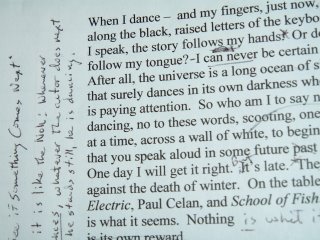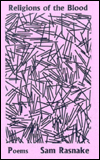the given world...
from my anthology of must read (a)merican poems
Jane Hirshfield
At Night
it is best
to focus your eyes
a little off to one side;
it is better to know things
drained of their color, to fathom
the black horses cropping
at winter grass,
their white jaws that move
in steady rotation, a sweet sound.
And when they file off to shelter
under the trees
you will find the dark circles of snow
pushed aside, earth opening
its single, steadfast gaze:
towards stars ticking by, one by one, overhead,
the given world flaming precisely out of its frame.
*
Jane Hirshfield, a master at giving life to unlikely objects, is a poet whose work is firmly grounded in Zen teaching. “At Night” is a poem that amazes the reader because of the living presence that is the world, that is the earth itself. Note the “steadfast gaze” of the earth toward the unknown. The closing lines present the reader with a precise image that is easily recognized, but one that is almost unapproachable in its vast scope. The “given world” – not the earth but the world the earth sees and experiences from its vantage point – is a view, “flaming precisely out of its frame”. What remains is the darkness and depth of a space that has no end yet is possibility.
The poem begins with a scene of horses that are in view, but a bit out of focus. Looking away from the center to the edges makes clarity possible. The black horses become a strong visual encounter in the poem: “cropping,” “winter grass,” “white jaws that move,” “steady rotation,” and “sweet sound”. After the stanza leap, the horses find shelter among trees, leaving behind the dug-out spots of snow. These circles function in a way as an opening into another world or another sort of existence. Hirsfield writes that you, the reader, will find these circles. The point of view then shifts from an observer to the scene to the earth itself – “its single, steadfast gaze” – and the reader identifies with that outward looking. Another possible reading is the gaze at the end of the poem is directly into the reader. Either way, a powerful transformation is at work.









5 comments:
There's a cinematic quality to Hirshfield's work, which is very evident in this work. While it's a fairly bucolic scene, there is a tension that builds line by line. The final three lines remind me of Rilke's "Archaic Torso of Apollo" in their construction and enigmatic tone.
I’m completely captured by the thought of knowing things drained of their color. I’m lost in Hirschfield’s statement. This is an amazing poem. From the beginning it unfolds like a flower and just keeps going. Thanks for sharing this Sam.
The whole poem is hinged on that single word:
given.
Or, rather, the poem's hinge is that single word:
given.
Hinge, hinged. Whichever you prefer.
But for me, the whole poem swings wide open when I reach that unexpected modifier for world.
The GIVEN world.
(incidentally, I've misread "world" as "word" every time I reread the poem)
Beautiful. Resonant.
Thanks for this, Sam and Happy New Year! (Your anthology has been one the best things about blogging in '06.)
Just returned from the Outer Banks.
Collin, I agree with you about Rilke's poem. Oddly enough, I read a lot of Rilke this past week.
Good point, Dennis, about the poem's unfolding.
Laurel, given is the poem's hinge. That's a great notion.
Suzanne, thanks for the kind words.
To each of you - Hope the soon-to-be year will be exactly what you need.
Post a Comment